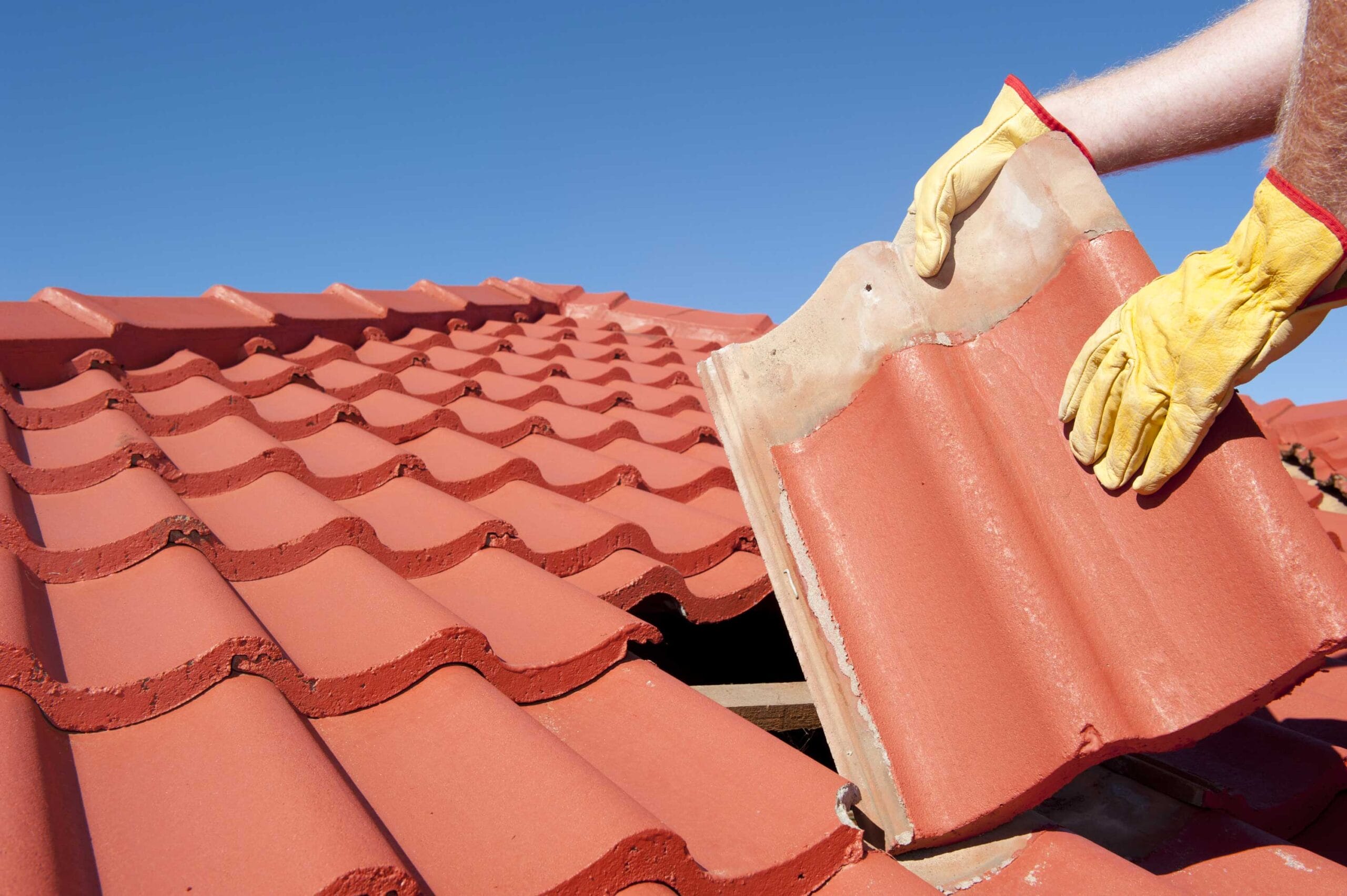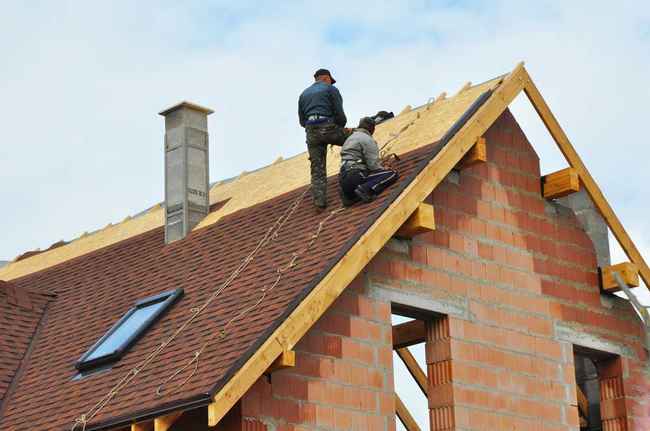In this guide, we’ll walk with you through the five key steps: understanding what’s covered under your policy; preparing before filing; reporting the damage; meeting with an adjuster and receiving their estimate; fixing your roof and settling the claim. It’s all about turning uncertainty into action.
We promise more than just answers – we give you the knowledge to feel confident when tackling unexpected roof issues.
Understanding Roof Damage And Insurance Coverage
Your roof is like a helmet for your home. But even the most robust helmets can get damaged, right?
Your homeowner’s insurance policy might cover different types of roof damage.
Not all policies are alike; some may provide more coverage than others. Some might cover more damage than others.
Identifying Roof Damage
Finding roof damage isn’t always as simple as spotting a leak inside your house – although that’s a pretty big red flag waving hello there.
Sometimes, it’s subtler stuff like cracked or missing shingles, sagging areas, or granules from asphalt shingles showing up where they shouldn’t be – think gutters and downspouts.
To Claim Or Not To Claim?
If you see signs of damage but are curious if they’re severe enough to file an insurance claim – don’t fret. Professional help is just around the corner.
Contact us at Designer Roofing & Restoration; we’ll thoroughly assess and guide you through the process if filing an insurance claim makes sense.
Preparing To File A Roof Damage Insurance Claim
The first step in filing a roof damage insurance claim is understanding your coverage. Knowing what’s included and excluded can save you from surprises later on. Please take some time to review your policy or ask your agent for clarity.
If you need clarification on the process, our insurance claims handling service at Designer Roofing & Restoration could greatly help.
Document the Damage
Your next move should be documenting all visible signs of damage. Photos provide evidence that strengthens your case when dealing with insurers. Include close-ups and wide-angle shots that give context to where the damage occurred on the roof.
Prevent Further Damage
Avoid more damage until repairs are made – but only if it’s safe. Cover broken areas with tarps or boards, which can also demonstrate proactiveness to your insurer.
Gather Necessary Information
You’ll need details like the date of the incident and the type of loss (e.g., windstorm). Also, gather documents related to any temporary fixes you’ve done – receipts are handy here.
Remember: The sooner these steps are completed after discovering roof damage, the better off you’ll be when starting an insurance claim.
Step 1 – Contacting Your Insurance Company
Have you got roof damage? Don’t panic. First, pick up that phone and dial your insurance company’s number. They’re the ones who’ll help kickstart your claim process.
You might wonder what you must say or ask when you call them. But don’t sweat it. You must briefly describe the damage, like “I found some missing shingles after last night’s storm.”
To make sure everything goes smoothly, have these key pieces of information ready:
- Your policy number (it’s usually on your insurance card).
- The date and approximate time of the incident causing damage.
- A general description of what happened (e.g., “A tree fell on my roof during yesterday’s windstorm”).
This will let them start an initial assessment even before they see your roof themselves.
Besides giving details about the damage, remember to question any doubts lurking in your head regarding their claims process—like how long it typically takes or if there are any specific forms needed from you for processing claims in Savannah, GA & Hilton Head, SC.
Step 2 – Meeting With The Insurance Adjuster
The insurance adjuster will drop by shortly, so now’s the time to tackle your roof damage claim. But don’t sweat it. Let us assist you in your preparations.
The first thing is to know what an insurance adjuster does. They’ll inspect your roof and assess the extent of the damage. Their report influences how much money you can get from your claim.
Preparation Is Key
Before their arrival, gather all necessary documentation like photos or videos of the damage, estimates for repair costs, and receipts for temporary fixes. This furnishes an unambiguous overview of the incident.
After The Inspection
A few days after their inspection, you should receive an estimate of your claim value based on their findings. Remember, this number isn’t set in stone yet, so hold onto that roofing hammer.
Step 3 – Receiving Your Claim Estimate
You’re on to the next step once the adjuster wraps up their visit. You’ll receive a claim estimate from your insurance company. But what exactly is this?
Simply put, it’s an educated guess of how much money you need to fix your roof damage.
The process they use might seem as complicated as cracking a secret code, but let me break it down for you:
- Your adjuster calculates costs based on local rates and material prices.
- This includes labor costs, too.
- They also factor in any potential extra expenses like removing debris or hiring equipment.
Sometimes, there may be discrepancies between the insurer’s estimate and what a contractor quotes for repairs. Don’t panic. There’s no need to worry; it’s likely just a difference in pricing structures between contractors. Remember that different contractors can have other pricing structures, so getting multiple estimates is always a smart practice. NAIC suggests this approach because not all damages are visible during an initial assessment, which could affect final repair cost estimations.
Step 4 – Repairing Or Replacing Your Roof
Your claim got approved. Great news. It’s time to roll up the sleeves and get that roof patched up.
Finding a Trusted Contractor
Identifying a reliable roofing contractor is the initial step to getting started on repairing your roof. They should be professionally experienced and offer fast response times like Designer Roofing & Restoration.
Pick someone who has worked with insurance claims before because they know the drill. This will make your life so much easier.
The Repair Process: What To Expect?
Rooftop work can feel daunting, but knowing what happens next eases some nerves.
Your chosen contractor starts by assessing the damage in detail, which forms the basis for their repair plan. You want to avoid surprises halfway through repairs.
Repair vs Replacement: The Big Decision
Sometimes, more than patch-up jobs are needed, and total replacement becomes necessary. Don’t fret; your insurance covers this, too, if deemed required after professional assessment.
Step 5 – Settling Your Insurance Claim
When the roof repair or replacement is finished, it’s time to finalize things with your insurance provider. Let’s explore how this process unfolds.
Your insurer will send a final payment once they get confirmation that the work is complete. This check often comes directly to you, but sometimes, it might go to your contractor if you’ve agreed to this arrangement.
Typically, two payments are made for an insurance claim: one for the initial emergency patch-up and another after repairs are finished.
Making Sure You’re Paid in Full
The last thing you want is to be short-changed after going through such an ordeal. So, make sure all costs have been covered by comparing invoices from your roofing contractor against what the insurer paid out.
If there’s any discrepancy, don’t hesitate to question your insurer about it. It could be as simple as a miscommunication or error that can be fixed easily once pointed out.
Closing Out Your Claim
To officially close out your claim, some insurers require written notice saying no more claims related to this damage incident will be made. But remember: always keep copies of everything for future reference.
You’ve now navigated through repairing or replacing your damaged roof and settling with insurance. While we hope you never need these steps again, at least next time, you’ll be a seasoned pro.
FAQs In Relation To 5 Steps To File A Homeowners Roof Damage Insurance Claim
How do I make a successful roof insurance claim?
To succeed, document all damage with photos and notes, contact your insurer promptly, and prevent further harm to the property if possible.
What not to say to the home insurance adjuster?
Avoid guessing or speculating about the cause of the damage. Only give recorded statements after consulting an expert or lawyer first.
What is roof loss settlement?
A roof loss settlement refers to the funds you receive from your insurer for repairing or replacing your damaged roof after a claim.
Why does the roofer get the depreciation check?
The roofer gets it because they’ll handle repairs. The check covers depreciation costs not included in your initial insurer payment.
Conclusion
Mastering the 5 Steps to File a homeowner’s Roof Damage Insurance Claim is no small feat. But you’ve done it.
You now know what roof damage your insurance may cover and how to spot that damage yourself.
Preparation is key. You learned how documenting the damage and gathering information can make filing smoother.
The dance with your insurance company doesn’t have to be daunting. Reporting the damage, meeting with an adjuster, and understanding their estimate – these steps are now in your toolkit.
And when it’s time for repair or replacement? You’re ready! Finding a contractor and settling your claim won’t catch you off guard anymore.





